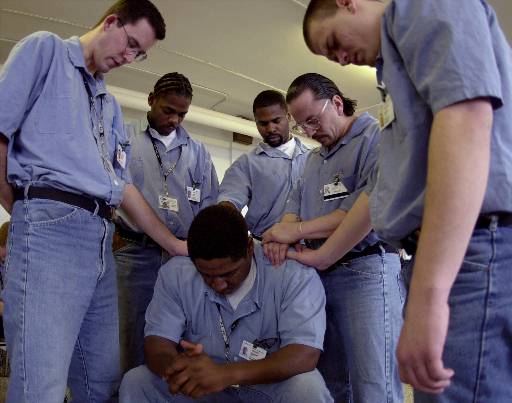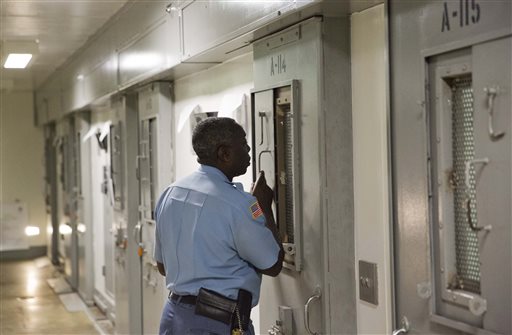In U.S. jurisprudence, the First Amendment rights of prisoners are sharply curtailed. When analyzing prisoner speech claims, the Supreme Court has displayed considerable reluctance to second-guess prison administrators.
Court defers to prison administrators when considering restrictions on prisoners’ speech
In Jones v. North Carolina Prisoners’ Union (1977), the Court upheld direct restrictions on efforts by prison inmates to form and operate a union — including a ban on soliciting other inmates to join the union, meetings among union members, and delivery of bulk mailings to inmates concerning the union from outside sources.
Delivering the opinion of the Court, Justice William H. Rehnquist established an extremely deferential standard for gauging the constitutionality of restrictions on prisoners’ speech. Citing “the wideranging deference to be accorded the decisions of prison administrators,” Rehnquist quoted Pell v. Procunier (1974) to the effect that “in the absence of substantial evidence in the record to indicate that the officials have exaggerated their response to [security] considerations, courts should ordinarily defer to their expert judgment in such matters.”

When it comes to a prisoner’s nonlegal mail, the courts draw a distinction between incoming and outgoing mail. Since the prison’s internal security can be seriously compromised by objects or communications entering the prison from the outside world, the deferential Turner test governs all restrictions on incoming mail. But the same elevated security concerns do not exist for a prisoner’s outgoing mail, such as the mail orders Jan Warren is considering making in this photo. She is looking through Prison Life magazine in the boardroom of Bedford Hills, New York, maximum-security prison in 1995. For prisoners who want to shop beyond their walls, their primary option is mail order from advertisements in catalogs and other publications. (AP Photo/Lisa Quinones, used with permission from the Associated Press)
The Turner test is a deferential standard for prisoner speech cases
Ten years later, in Turner v. Safley (1987), the Court upheld broad restrictions on inmate-to-inmate correspondence — and, in the process, reaffirmed its commitment to a deferential standard in prisoner speech cases. Announcing a test that prevails to this day, Justice Sandra Day O’Connor held that “when a prison regulation impinges on inmates’ constitutional rights, the regulation is valid if it is reasonably related to legitimate penological interests.”
Justice O’Connor’s opinion in Turner identified four factors to consider when applying this standard:
- Whether there exists a valid, rational connection between the regulation and the governmental interest put forward to justify it;
- Whether inmates are left with alternative means of exercising the right that the regulation restricts;
- Whether accommodating the asserted right would have a significant ripple effect on fellow inmates or prison staff;
- And whether there is a ready alternative to the regulation that fully accommodates the asserted right at a minimal cost to valid penological interests.
As applied by the federal courts, the first of these factors is most important. So long as the government can justify its regulation as promoting a legitimate interest in prisoner rehabilitation or prison security — reducing the likelihood, for example, of riots, escape attempts, suicide, physical violence or sexual harassment — it will be upheld unless “the logical connection between the regulation and the asserted goal is so remote as to render the policy arbitrary or irrational.”
In recent years, the Supreme Court has maintained its commitment to the deferential Turner test when deciding prisoner speech cases. In Shaw v. Murphy (2001), the Court held that restrictions on prisoner-to-prisoner correspondence should be analyzed under the Turner standard even if they inhibit a prisoner’s ability to provide legal assistance to a fellow inmate.
Applying the Turner test, federal courts have rejected a wide variety of speech clause challenges directed at prison regulations. They have sustained, for example, restrictions on prisoner access to typewriters and word processors, to telephones, and to subscription magazines and newspapers.
Outgoing mail and legal mail cases receive heightened scrutiny
In the realm of prisoner speech claims, there are only two situations in which the courts depart from Turner and apply heightened scrutiny:
- When the government censors outgoing prisoner mail;
- And when the government interferes with a prisoner’s “legal” mail (correspondence between a prisoner and his attorney).
When it comes to a prisoner’s nonlegal mail, the courts draw a distinction between incoming and outgoing mail. Since the prison’s internal security can be seriously compromised by objects or communications entering the prison from the outside world, the deferential Turner test governs all restrictions on incoming mail. But the same elevated security concerns do not exist for a prisoner’s outgoing mail.

Heightened scrutiny is available to free exercise claimants who invoke the Religious Land Use and Institutionalized Persons Act of 2000 (RLUIPA). RLUIPA provides that the government shall not impose a substantial burden on the religious exercise of a person residing in or confined to an institution even if the burden results from a rule of general applicability, unless the government demonstrates that the imposition of the burden on that person is in furtherance of a compelling governmental interest and is the least restrictive means of furthering that compelling interest. In this photo, Winfield Correctional Facility inmate Lincoln Williams, center, sits while fellow inmates pray after a “Heart to Heart” session Feb. 7, 2001 at the prison in Winfield, Kansas. The session is part of a faith-based prison program called The InnerChange Freedom Initiative. (AP Photo/Charlie Riedel, used with permission from the Associated Press)
The Martinez test is used in outgoing mail cases
Accordingly, when the government censors a prisoner’s outgoing correspondence, the Turner test is not appropriate. Instead, the proper test is a form of heightened scrutiny derived from Procunier v. Martinez (1974) known as the Martinez test. There are two factors in the Martinez test:
- The regulation must further an important or substantial government interest unrelated to the suppression of expression;
- And the restriction must be no greater than necessary for the protection of that interest.
Does the heightened scrutiny of the Martinez test apply to all restrictions on outgoing prisoner correspondence? Apparently not. Although the Supreme Court has not answered this question, it appears that Martinez only applies to governmental censorship of outgoing prisoner correspondence. The deferential Turner test should be used to analyze all other regulations that affect nonlegal outgoing prisoner mail.
Prisoners have a First Amendment right to be present when their legal mail is opened
With regard to legal mail, the Court applies heightened scrutiny to the speech claims of prisoners. Federal courts have expressed “heightened concern” for protecting the privacy and the unimpeded flow of all correspondence between a prisoner and his attorney. Prisoners have a well-established First Amendment right to be present whenever prison officials open their legal mail — and the officials may open it only to check for contraband, not to read it. Any effort by prison officials to read, withhold, restrict, or censor a prisoner’s legal mail must be subjected to heightened scrutiny.
Turner test used as standard for other First Amendment guarantees
Turning from the speech clause to the other guarantees of the First Amendment, we find that Turner again provides the presumptive standard for claims advanced by prisoners. Overton v. Bazzetta (2003) established that Turner governs prisoner claims that invoke the First Amendment’s protection for freedom of association. The Court’s latest prisoner free expression decision, Beard v. Banks (2006), also upheld restrictive prison policies, rejected inmate First Amendment claims, and showed broad deference to prison officials.

The Court has held that prison security is a compelling government interest, and it stressed that a prison is free to resist requests for religious accommodations that either impose unjustified burdens on other prisoners or jeopardize the effective functioning of the prison. The aftermath of a riot is seen in this photo. An inmate’s correspondence is seen on a floor littered with broken glass and debris during a tour of the California Institution for Men in Chino, California, Aug. 11, 2009. Men’s blood-soaked mattresses, singed bedding and abandoned backboards and medical supplies littered the campus of the Chino prison, a testament to the violence of a weekend riot that shut down part of the institution and injured nearly 200 inmates. (AP Photo/Reed Saxon, used with permission from the Associated Press)
Heightened scrutiny is available for free-exercise cases
But heightened scrutiny is available to free exercise claimants who invoke the Religious Land Use and Institutionalized Persons Act of 2000 (RLUIPA). In enacting RLUIPA and the earlier Religious Freedom Restoration Act (RFRA), Congress intended to depart from the Turner reasonableness standard, which the Supreme Court had established for prisoner free exercise claims in O’Lone v. Estate of Shabazz (1987).
RLUIPA provides that the government shall not impose a substantial burden on the religious exercise of a person residing in or confined to an institution even if the burden results from a rule of general applicability, unless the government demonstrates that the imposition of the burden on that person is in furtherance of a compelling governmental interest and is the least restrictive means of furthering that compelling interest.
Prison security is a compelling state interest
This appears to be a strict scrutiny test, but in Cutter v. Wilkinson (2005) the Supreme Court cautioned that courts must apply the test with “due deference to the experience and expertise of prison and jail administrators in establishing necessary regulations and procedures to maintain good order, security, and discipline, consistent with consideration of costs and limited resources.” The Court specifically noted that “[l]awmakers supporting RLUIPA were mindful of the urgency of discipline, order, safety, and security in penal institutions.” The Court held that prison security is a compelling state interest, and it stressed that a prison is free to resist requests for religious accommodations that either impose unjustified burdens on other prisoners or jeopardize the effective functioning of the prison.
The Court showed sensitivity to an Arkansas inmate’s RLUIPA claim in Holt v. Hobbs (2015). The Court ruled that prison officials violated the inmate’s rights when they refused to allow him to grow a very short beard. Prison officials had argued that the restriction on even short beards was necessary to further prison security. They contended that prisoners could hide contraband in their short beards
- Writing for the Court, Justice Samuel Alito rejected that argument: “We readily agree that the Department has a compelling interest in staunching the flow of contraband into and within its facilities, but the argument that this interest would be seriously compromised by allowing an inmate to grow one-half inch beard is hard to take seriously.”
Prisoners must exhaust all available administrative remedies before bringing lawsuits
Finally, lawyers who bring First Amendment claims on behalf of prisoners must pay careful attention to the Prison Litigation Reform Act (PLRA). Section 1997e(a) of the PLRA provides that “[n]o action shall be brought with respect to prison conditions … by a prisoner … until such administrative remedies as are available are exhausted.” Courts entertaining First Amendment challenges to prison regulations have held that such a lawsuit must be dismissed (without prejudice) if the prisoner fails to plead that he has exhausted all available administrative remedies.
This article was originally published in 2009. Kevin Francis O’Neill is an associate professor at Cleveland-Marshall College of Law where he teaches First Amendment, Evidence, Civil Procedure, and Pretrial Practice. His scholarship focuses on the Speech Clause of the First Amendment. Prior to entering academia, Mr. O’Neill served as the Legal Director for the American Civil Liberties Union of Ohio where he focused special attention on First Amendment issues, reproductive freedom, police misconduct, and government mistreatment of the homeless.

